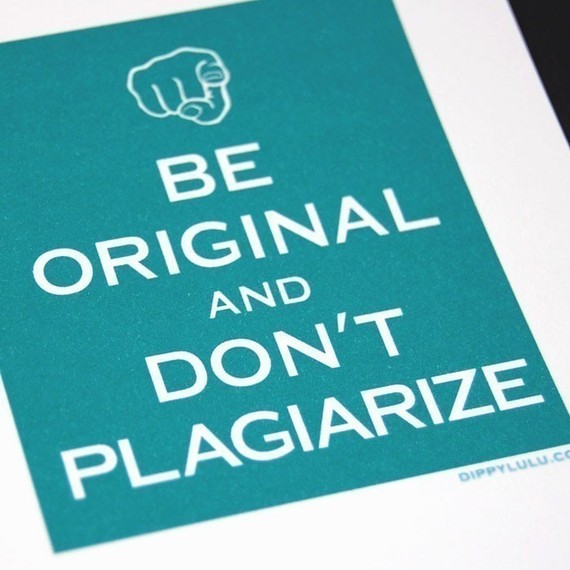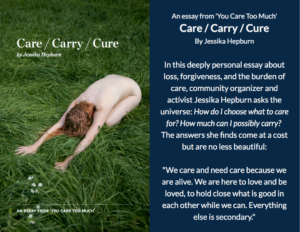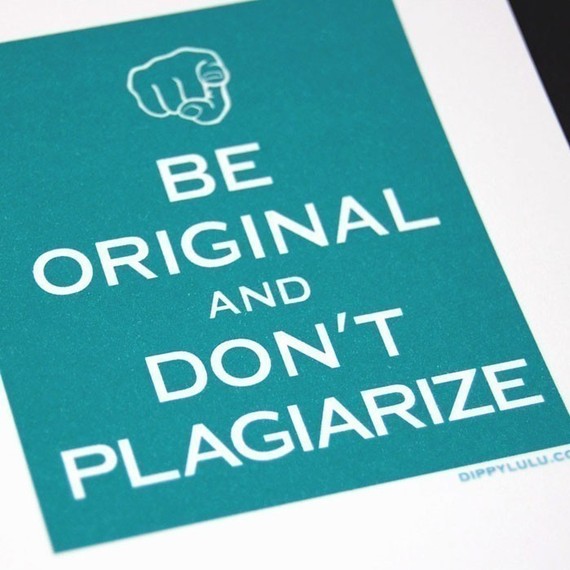
{be original & don’t plagiarize card by dippylulu}
by Jessika Hepburn, Editor
First off I want to chat about the difference between copying and stealing-Picasso said that “good artists copy, great artists steal” what does that mean? It means that any work of art involves elements “stolen” from something else. A beautiful photograph steals an image of a place, person or thing, a painting steals elements of artistic styles developed over centuries and a new purse steals techniques from other sewers. The stolen elements are taken and incorporated into something new-that can then be stolen and developed into something new again. Really stealing is at the root of any innovation.
Copying though is entirely different-copying means to replicate something that has already been created, not to reinvent it but to duplicate it. It is also a form of stealing but without the originality implied in the Picasso quote. It is a shortcut to doing the actual work of taking an idea and making it your own. It is also highly unethical. Think of the time and effort the artist dedicated to developing a new idea, the love put into the creative process, and the joy they felt when they created something entirely unique to their style. Then think of how it would feel for someone to come along and think “Hey-that’s a great idea, why didn’t I think of that!” then copy it to sell to their own market. That’s yucky on all kinds of levels and in most cases illegal.
But it happens ALL the time. From big businesses like the Gap and Anthropologie copying the work of indie artists to small businesses or individuals copying the work of bigger artists so they can capitalize on their success. It also happens in blogland-bloggers see photo spreads or content they love then copy and paste it word for word into their own blogs. Copying is the ultimate example of a lack of creativity and awareness of the time, energy and talent that went into the creation of the original. Copying is a massive issue in the handmade world right now and is dangerous for all of us. It creates an atmosphere of distrust and unhealthy competition. While competition has it’s place it is not what we are here for, we are here to support each other’s creativity and celebrate our talents!
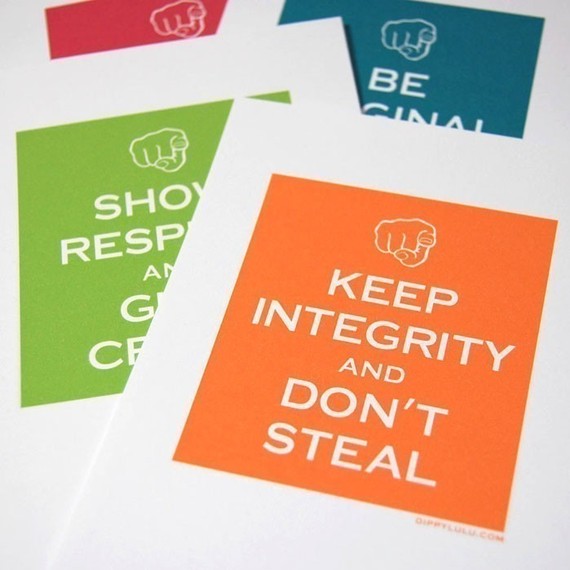 {keep integrity & don’t steal card by dippylulu}
{keep integrity & don’t steal card by dippylulu}
Let’s look at some cases of blatant copying then we’ll talk about how you can protect your designs, words and images + how you can be a whistle blower and stop copycats in their tracks. We have a responsibility to talk about these issues and protect each other so that we can ensure our creative community thrives-so let’s get to it!
In these examples ideas were stolen directly from indie artists by big business-typically it is a designer who works for these companies taking the idea, altering it a bit and taking the credit for the design. As wonderful as Etsy has been for handmade it is also a gallery of ideas for lazy designers to copy. It is the responsibility of the company to make sure their designers are only developing unique ideas but quite often they don’t. Companies like the Gap, Tiffany’s and Paperchase should know better and take responsibility for doing their due diligence but as we can see that doesn’t always happen. Trying to make these companies accountable for their theft is hard when indie artists obviously don’t have the big budgets for legal expenses. This is where our collective power comes in-the ability to spread the word via Twitter, Facebook & blogging to make companies accountable, to demand ethical business practices and to protect each other’s rights.
I am not doing side-by-side examples of the copying-think of this as an ethical investigation. Please visit the links/evidence, look at the images on their sites & decide for yourself where you stand.
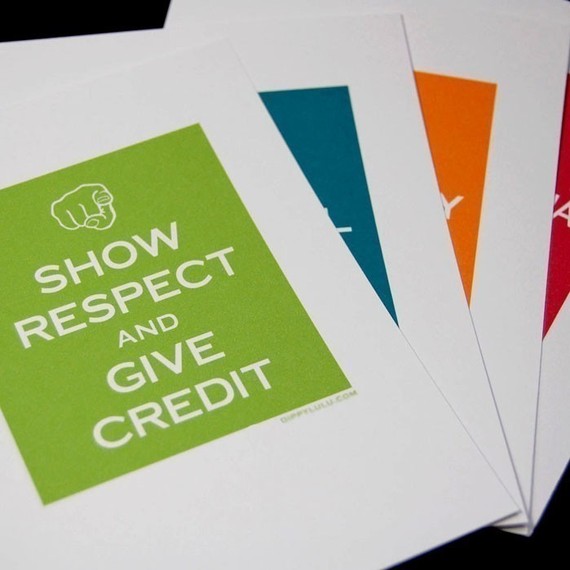
{show respect & give credit card by dippylulu}
Case #1: Gemma Corell & The Gap
This just makes me furious-Gemma Corell has a very unique and individual style, her work is typically instantly recognizable and she is a well known, published artist. The Gap quite obviously copied her design but because they made changes to the original she is unable to do much in terms of making them accountable. Shame on you Gap-you ought to be embarrassed. Gemma has created a Facebook group called Designers & Illustrators Against Plagiarism to help raise awareness of copying in the industry so be sure to visit it & see what’s happening there.
The Evidence: Gemma shows her designs + the copies here on her blog.
Case #2: Su Blackwell & Tiffany & Co.
Su Blackwell is one of my all time favourite artists and is an innovator in the world of paper cutting & book sculpture. Her work is immediately recognizable. So it is really disgusting that mega-store Tiffany’s consulted with her then took her ideas & had someone else do the work based on her concepts without crediting her. Then to deny it? Shocking. Really, could it be more obvious?
The Evidence:
A. Su shares the images & info about her consultation with Tiffany & Co. on her blog
B. Su is asked to remove images from Tiffany & Co. because she didn’t “ask permission”
Case #3: Hidden Eloise + Paperchase
This case is a tangled web of denial and accusation that is too complex to summarize here. Follow the story through the posts/evidence listed below. What I want to focus on here is that it was the power of Twitter and social media that generated some kind of admission from the company. When faced with hefty legal fees in order to push her claim that Paperchase had knowingly sold items featuring designs stolen from her images, Hidden Eloise took to Twitter asking the art & design community to do the right thing by calling for accountability. And they did! For all that we love making pretty things the handmade community can be fierce when justifiably angered.
The Evidence:
A. Follow the story through these posts: 1, 2, and 3.
B. An article from the Guardian on the Twitter movement to support Hidden Eloise.
C. Dealing with Infringement article from Try Handmade
What you Can Do To Help Others:
Really, public censure is the best way to cause enough of a fuss to make big companies accountable. Blog about it, Tweet about it, send them a letter. Send another letter. Also, whenever you spy copying be sure to let the creator of the original design know. The biggest most important thing you can do is to shop carefully, buy your products right from the source and support the artists directly. If you have a relationship with the artist you are buying from you can be sure the work is original! Choose retailers that are well known for their support of handmade and that have a good reputation in the handmade community. Pay more for quality-handmade is not about economy or getting a good deal-handmade is about treasuring the love and talent that went into the creation of the product. It’s worth every penny to know that you are supporting another person’s creative dream.
What You Can Do To Protect Yourself:
1. Be Original: Focus on creating a brand and style or product that is uniquely yours. If you are constantly evolving and developing as an artist, designer, writer, blogger and you always let your own style and voice infuse whatever you do, it will be easy to spot a copycat when they come along. Other people will recognize your authenticity, they won’t want a bad imitation-they’ll want what you have to offer and will call out the copiers when they see them. There is this great new blog called Be Your Original Best that is “an effort to promote a COPYCAT FREE artistic industry & creative community.” The message of the blog is to encourage the creative community to: “ be inspired. be creative. be ORIGINAL. be your best.” I agree wholeheartedly. If we create a strong community based on integrity, originality and genuine support of handmade then there will be little room for the copycats and lots of back-up when we are faced with them.
2. Educate Yourself: Get familiar with the copyright laws specific to your industry and country, read examples of cases that could have been you and find out what the outcome was, check out what resources are available to you and take a look through some of the links listed below under resources.
3. Stake Your Claim: Make it clear on every image you put online or associate with your work that you are the creator and that your work is original. If you are listing on Etsy or online anywhere, make it clear in the item description that the item is an original design and copying is not allowed. Add a watermark or prominent logo to images you put online. You can also formally register your designs. Read more about giving notice, registering your work and deterring would be copycats in this article written by lawyer Kara J. Jensen Zitnick over on the LaunchHER blog.
4.Gather Evidence: If your work has been copied the first thing to do is take as many screen shots & gather as much evidence as possible in case they remove the item after being contacted. Keep records of your own artistic process and make sure you date them too! Sketchbooks or blog entries that document the creation of your items, as well as sales information will all help reinforce that the original design was yours.
5. Put Your Foot Down: Send a very clear letter telling the copycat to Cease & Desist meaning to immediately stop selling the copied work. This might be all you need to do to get the offender to stop making money off your work. Keep records of any communication between you and the copycat.
6. Seek Legal Advice: I know, it sucks, not only has your idea been stolen but now you need to PAY money to get accountability. Before you spread the news to your online community though-especially if you are up against a BIG business, get some counsel. If you can’t back up your claims you might find yourself getting sued for libel or slander! So be sure to talk to a lawyer you trust with experience in copyright law.
7. Ask For Help: The handmade community is loving and supportive so if you’ve had your designs stolen you can spread the word and ask for help in applying pressure on the copycat. If you are 100% sure that your designs have been copied and can back up your claims, especially if you are trying to get another small business to ‘fess up and stop copying then blogging, tweeting & sharing with other online friends can definitely help apply some pressure.
RESOURCES:
In the US:
US Copyright Office: Offers lots of information and PDF’s on copyright law & registration.
ARS (Artists Rights Society):Represents the intellectual property rights of over 50,000 artists & is a major copyright, licensing, and monitoring organization for visual artists in the United States. They also have an online resource library of copyright information.
LaunchHER: LaunchHER supports handmade and women owned businesses by generating buzz & exposure + offers professional public relations, branding, business development and legal services.
In Canada:
Canadian Intellectual Property Office: Has all of the information needed to help you register your designs.
Canadian Artists Representation Copyright Collective Inc. : Offers a variety of copyright enforcement services to Canadian artists.
CARFAC: Has a large online resource library of information about copyright & visual art in Canada.
In the UK:
UK Handmade: A great article about design registration in the UK
UK Intellectual Property Office: Design registrationFAQ
Design & Artists Copyright Society: A non-profit visual arts rights organization.
SOURCES:
I consulted an insane number of articles before writing this post & have been reading on this topic for months now. Below is a list of some of the most influential articles I read while researching this post.
PikaLand:
Copycats & Lessons We Can Learn
Creativity, Competition and Copycats
Jessica Hische:
Poppytalk:
What Happened to the Magic? Part 1
The Sidetrack Cafe #3-Copycats
Wolfie & The Sneak:
Drawing the Line on Design Theft
Scoutie Girl:
I hope that this quite epic post serves as a resource for all of you-please share your thoughts and experiences with copying & copyright in the comments below as well as any resources you know of that I have missed. I know we can all work together to make sure that originality is valued and that copying has no place in our creative community.

